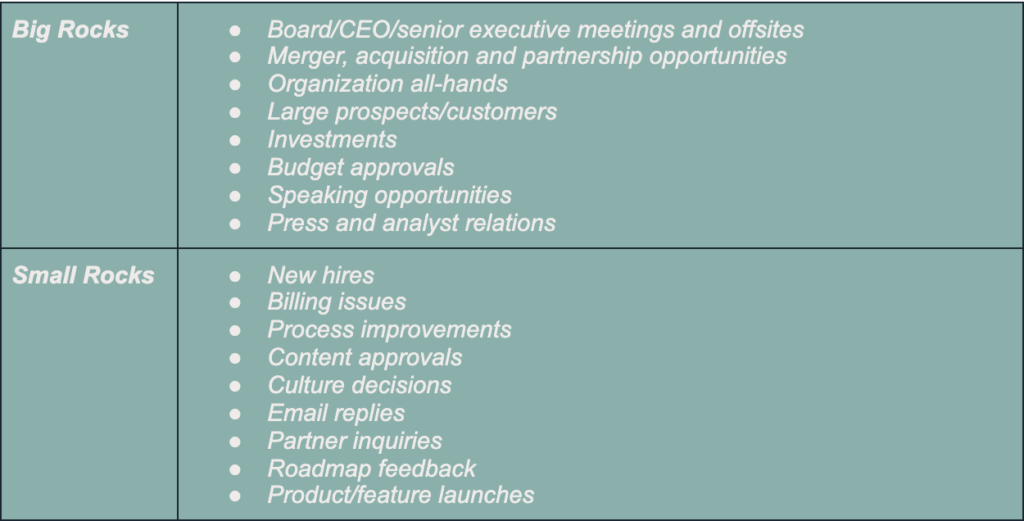Prioritization in a startup and prioritization in a massive corporation are very different. Regardless of company scale, many of the lessons of how to deal with it persist.
The challenges of how to set business priorities and deliver results are the same, but people have different work styles, leadership and team viewpoints. And aligning the decisions you have to make as an executive with the major business priorities can be harder to pin down when organizations balloon to thousands of people.
I’ve written before about my views on startup vs. corporate based on my experiences at Dyn, and then Oracle, and why I’m at home building York IE. When I look back on my time at Oracle, I do so quite fondly — even though I’m a startup guy at heart. I enjoyed my time in the 150,000-person company leading strategy for a team of 8,000. (Eye-popping numbers!) My colleagues were welcoming, dedicated and smart. I also feel like we all accomplished a great deal, learned a ton, and felt many rewards for the commitment. It was hard yet fun and went by fast.
The Story of Big Rocks and Small Rocks
When I joined Oracle via acquisition, I first worked for then-President Thomas Kurian, who is now CEO of Google Cloud. It was short-lived, as Thomas had over 35,000 reports in his org (yes, you read that right!) and he relinquished control of building Oracle Cloud Infrastructure to a smart, patient, thoughtful and strategic wunderkind named Don Johnson, who I worked for over the majority of my three-year run.
Don was and still is a direct report to Larry Ellison and is the driving strategic force behind Oracle’s multi-year, multi-decade existential quest to transition into a cloud platform company. Don came from a seven-plus-year stint helping build Amazon Web Services (AWS) and was a pioneer in early cloud storage and databases. Beyond his expertise and intellect, it was really his temperament and relationship with Larry, Safra Catz, the late Mark Hurd and other senior executives that made him the right person at the right time. It’s also why he remains such a respected senior executive now.
I have a great deal of respect for Don. He’s quite unassuming and doesn’t love the bright lights, so in turn he doesn’t get a ton of fanfare. But the work he’s accomplished and is doing now — leading his orgs and tactfully pulling the company through this mammoth transition — should get called out, because he deserves it.
When I worked for Don, he was in Seattle and I was in Manchester, N.H., so the times when we’d get together to have our strategic syncs were quite precious, whether they were on the phone, on video calls or in person in Redwood Shores, Calif. or in the Pacific Northwest. I love matching strategic wits and dreaming big, and we did this during every encounter, at a Fortune 100 scale, and the progress felt palpable.
During this time, we began a process that worked for many years around organizing our shared priorities into a list that included distinct buckets we called Big Rocks and Small Rocks. We’d quite obviously start with the Big Rocks and finish with the Small Rocks that were often less pressing.
Sometimes, one Big Rock would take the whole 90-minute phone call or three-hour dinner, and that was OK. I can remember even from time to time flipping the script and going rapid-fire through the Small Rocks just to clear the list. (There’s nothing worse than lingering decisions, even small ones — especially for colleagues waiting for direction.) Or sometimes many Small Rocks would merge into one Big Rock.
Don paid me to figure this all out, and if any rocks were not covered and needed action, to make decisions within the lanes of our strategic alignment.
There are boatloads of decisions senior executives need to make in large organizations, and trust with your boss and peers must be paramount. This is also true in small companies and startups, but in those environments the team time is far more together and captive.
Business Prioritization
When setting business priorities you must also consider individuals’ work styles, which adds complexity. There are two types of work styles: single-threaded (Don) and high-throughput (yours truly). Both are purposefully important.
I needed to eliminate the noise and minutia with Don and ensure our precious time was laser-focused on the Big Rocks. Both work behaviors lead to tremendous progress, and you need these complementary work styles and skill sets in organizations for companies to thrive. Each style works differently for each individual and it is incredibly important to know who is who and which is which for things to gel consistently.
When you understand the core strategy of your company, the business priorities of your boss, and the personalities and work styles that make team members uniquely able, it’s far easier to know what pile of rocks, Big or Small, certain efforts should fall into. You’ll feel a lot better writing down the things you need to do too and prioritizing the two piles based on what tasks need to get done to conquer mountains. Thanks to Don for the collaboration!
For more startup stories, sign up for our weekly newsletter and follow us on Twitter.








